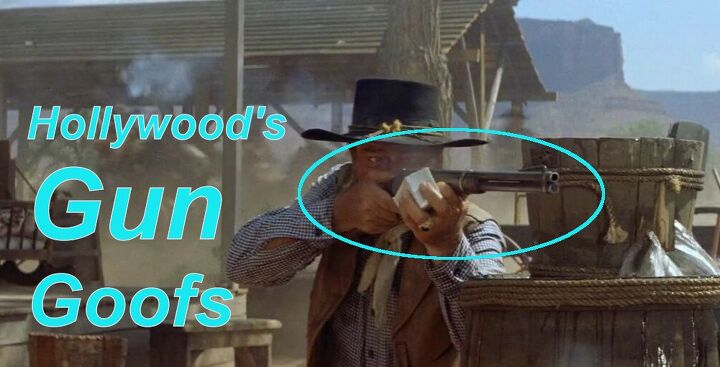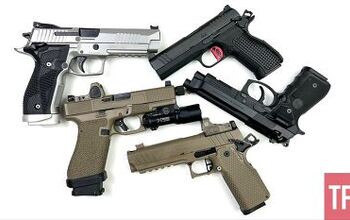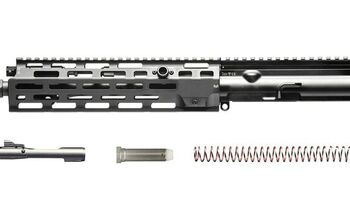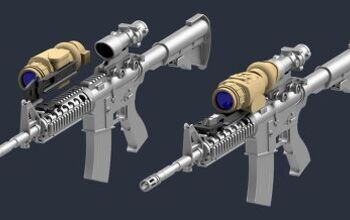TV Guns vs. Real Guns: What Hollywood Gets Wrong

Television, movies and whatever you call the in-between streaming content on Netflix, Hulu, et. al. will show you all sorts of gunplay—and all sorts of firearms mistakes. Sit down and watch a shoot-em-up show with any sort of gun nerd, and you’ll start to hear whining about how they messed up something as soon as they bring a firearm out. While we could probably complain all day long about Hollyweird’s inability to get their gun details straight, here are a few particularly egregious errors that should be stamped out.
Hollyweird Firearms @ TFB:
Not every shotgun makes a pump-action sound
It happens all the time—somebody picks up a double-barreled shotgun in a movie, and they immediately splice a pump-action sound into the soundtrack.
The most egregious example might be from the cartoons, where bartender Moe Szyslak’s scattergun always makes a Remington 870-esque sound when he hauls it out from under the counter:
Why is this? For some reason, Hollywood thinks that every time somebody touches a shotgun, they have to start pumping the action:
Shotguns are not an all-powerful weapon on par with a rocket launcher
Yes, we agree with Clint Smith, shotguns are powerful fight-stoppers and can remove chunks of meat from a target, instead of making neat little holes. But even our favorite gravelly-voiced firearms instructor would tell you that Hollywood leaves viewers with unrealistic expectations that a shotgun has power on par with a Panzerschreck. You could pick a scene from any number of films, but I blame director John Woo for starting this madness, with shotguns that fire exploding rounds whenever necessary to spice up the footage. Enjoy the montage below:
Aiming is a lot easier when your gun has sights
Hollywood armorers have a weird habit of taking the sights off guns used on-set. One of the best examples is the .45-70 Thompson-Center pistol used in the movie Hard Target.
Another example, from the Robert Duvall oater Broken Trail. Look at that dead-eye shooting, all without a front sight:
This has gotten even worse in recent years as AR-pattern rifles have become more and more common in movies. Lazy armorers don’t bother to put iron sights or optics on flat-top ARs. Or the iron sights are flipped down, like Jake Gyllenhaal’s in the movie Ambulance; see below
You get the idea. It’s a wonder these guys ever hit a target at all.
Silencers don’t make a “pew pew” sound
Silly movie armorers. Suppressors (silencers) don’t make a pew-pew sound. That’s the noise that “finger guns” make! But for years, movie sound effects teams got this wrong:
Suppressed firearms have gotten slightly more realistic in films in recent years, but still, as you can see from John Wick 2, the sound effects team will greatly exaggerate the silencing effect of a suppressor:
The Winchester Model 1892 was not in every western conflict ever
I will say that, in recent years, Hollywood has moved away from using the Winchester Model 1892 as a prop for every single Western film. But in the 20th century, whether the was set in the 1840s through to the end of the 1880s, the Model 1892 appeared regularly, just like a Colt Peacemaker, as a stock weapon whenever a rifle was needed.
You may grant artistic license to some films, but in a movie like Pat Garrett and Billy The Kid, focusing on an outlaw who died in 1881, it’s silly to show off a rifle that didn’t come into production until more than a decade after The Kid died:
Older Westerns were generally very bad at this; Comancheros was one of the worst of them all. Giving John Wayne a Model 1892 for a film set in the 1840s makes as much historical sense as giving Doc Holliday a Thompson submachine gun for a film showing the Shootout at the OK Corral… which thankfully hasn’t happened. Yet.
Cowboy machine gun fantasy
Since we’ve raised the unpleasant spectre of putting machine guns in a western, let’s look at one of the most common Hollywood tropes of all: A historically inaccurate abomination of a fake machine gun, cobbled together by a props team that must have been high on superglue. One of the worst examples is this scene from A Fistful of Dollars. Where’s the ammunition? (And did you notice that likely anachronistic Model 1892 at the start?):
Another highly entertaining, but completely ridiculous use of a bodged-together machine gun prop, from the classic spaghetti western Django:
At least they remembered to include ammunition in that sequence.
All-powerful, all-accurate Uzi submachine guns
Whoever ran Uzi’s marketing team in the 1980s was a genius. I’m not saying there’s anything particularly terrible about the Uzi, although it wouldn’t be my first choice if my fairy godmother granted me any SMG I desired. But I will say that it also probably wouldn’t have been the first choice of every tough guy and mercenary in the world, despite 1980s action movies leading you to believe as much. The Christopher Walken classic The Dogs Of War is but one example of this:
Ironically, such films were probably responsible for saving lives in the 1980s, by leading gang-bangers to believe they didn’t actually need to aim during a drive-by shooting—if you could spray and pray from the hip, like the movies, surely it was good enough?
Conclusion
Like I said at the start, we could complain about movie gun mistakes all day long. If you’ve got some irritating examples in mind, drop ‘em below; maybe we’ll revisit this down the road, and in a perfect world, some armorer might actually read this article and be motivated to get things right.














![[SHOT 2025] Bog Launches New Deadshot Line Of Shooting Sticks](https://cdn-fastly.thefirearmblog.com/media/2025/01/22/15241/shot-2025-bog-launches-new-deadshot-line-of-shooting-sticks.jpg?size=350x220)



![[SHOT 2025] Taking a Look at the New CZ BREN 3](https://cdn-fastly.thefirearmblog.com/media/2025/01/28/10541/shot-2025-taking-a-look-at-the-new-cz-bren-3.jpg?size=350x220)




Comments
Join the conversation
I tell all my friends that anything you learned from watching movies or tv is wrong, don’t get me started on aviation stuff
In defense of the “excessive” usage of the Winchester 1892 rifle, they, and their Spanish made counterparts, were a lot easier to get ahold of in quantity. They were made until WW2.